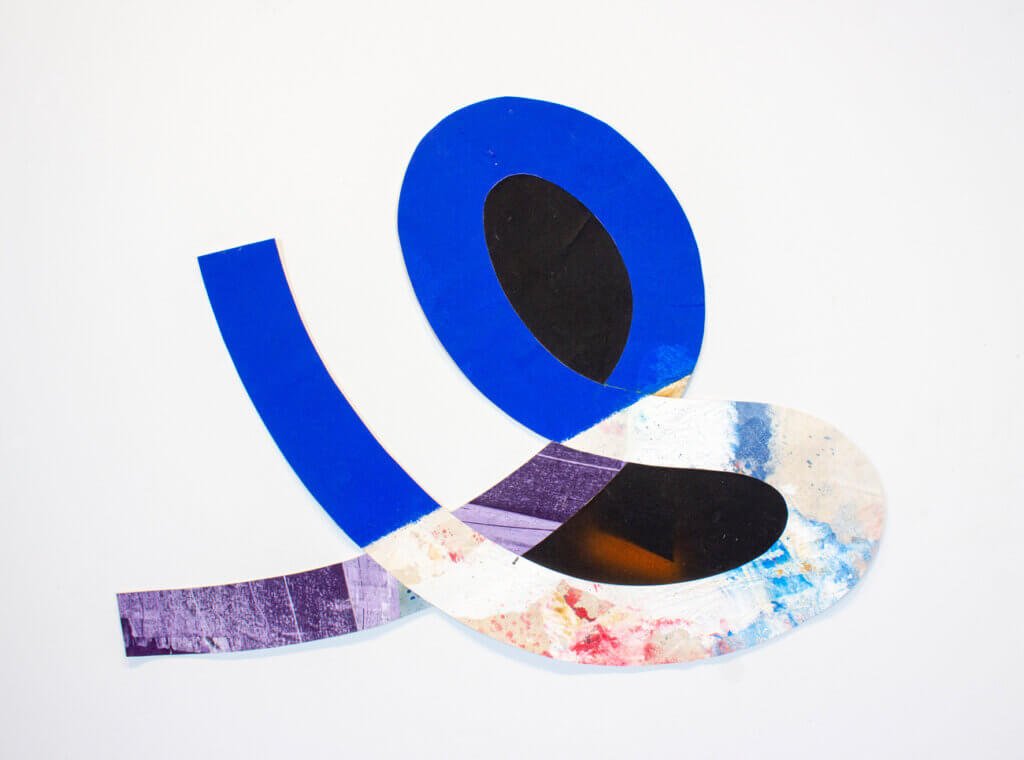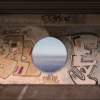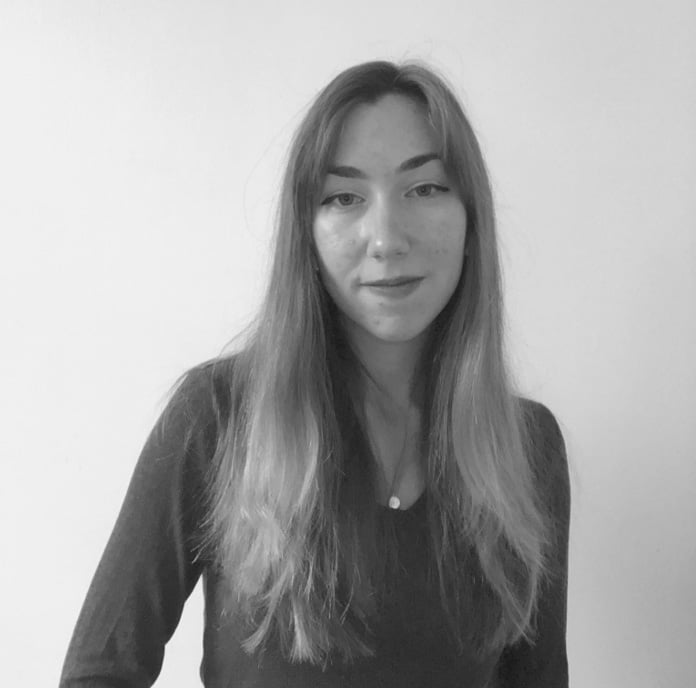Navigating the work of San Diego-based abstract painter Matt Rich can be a bit like entering a warped kaleidoscope of colour and form. Rich’s work won’t necessarily leave you with tunnel vision, but it will leave you feeling as windswept as a pad of paper dancing in midair. With his bright compositions, which hover tensely above the gallery wall and contend with every breeze, draft, and breath which pass through the space, Matt Rich conjures this disorienting and charged sense of movement carefully and intentionally in each work.

Acrylic on canvas
24 x 33 inches (61 x 83.8 cm)
Courtesy of Halsey McKay Gallery
Rich’s practice as a painter is unique both in the artist’s relationship to it’s second-most essential element; the canvas, as well as in terms of the artist’s open-ended style of artistic communication. In the studio. Rich eliminates the stretcher bar of his canvases and embraces their inherent flatness and potential to take on wild forms and figures.
Layers of canvas undergo cutting, carving, and reconstruction, while fields of colour and patches of abstraction lace together with hints of familiar signs and symbols. Nothing is straightforward. In fact, both process and result are rife with contradiction and duality, which only enhance their richness. Rich’s approach to painting is a bit like scrambling puzzle pieces and finding a whole new sense of resonance in the result.
In his most recent solo exhibition, And And And taking place at Halsey McKay Gallery, this winter, Rich employs all the visual and thematic tactics that make his work compelling while further exploring the line between representation and abstraction. In his third solo show to date with Halsey McKay Gallery, Rich’s use of the ampersand as both symbol and form takes centre stage and parallels the artist’s mindset itself as Rich’s work continues to evolve as time moves forward.
As the exhibition title suggests, Rich’s work seems to forever open new avenues to question the limits of medium and the possibilities of abstraction. This approach would be nothing without Rich’s ability to capture physical, visual, and ideological tension in his work. Matt Rich’s embrace of the challenges he sets for himself as a painter guarantees his practice will be ever-growing and ever-changing, as contemporary art always should.
Q: Your new exhibition at Halsey McKay Gallery is your third solo show with the gallery. What was your thinking behind the title of the exhibition, And And And besides the presence of the ampersand as image and form throughout the collection? Did you perhaps find yourself thinking about continuity and extrapolation in your own practice or life when producing this show?
A: Absolutely. The symbolic act of balancing two things that cannot or do not join together seems a very important measure at this moment in time: for politics, personal relationships, many things. The ampersand recognizes difference or the unknown and asks for a relationship to that different thing or idea. My first ampersand was made for a group exhibition, and without knowing where my piece was going to be located, nor in what context, I wanted to address the idea of the show as a grouping in a sentence-like unit. I wanted to give substance to that gap between pieces on a wall. I wanted to make the connective tissue visible and give it form.
Q: While your work is overall based in abstraction, what is your connection to symbols and signs in the context of this particular collection? Is there a line between representation and abstraction you find yourself playing with here?
A: Much like the meaning of the ampersand, abstraction invites for more than one thing to exist at once in a composition. Even if a symbol is not recognizable in the works, they are made up of basic, identifiable geometric shapes joined into something that is more spatially and visually complex or even contradictory.
The physical form of the ampersand is brilliant, rich and compact: with two similar but different interior spaces—one looping to a point and the other looping to two points connected by a straight line; two “X”-shaped crossings; and two terminating lines jutting out that frame three open-ended areas on the exterior of the form. I find no end to the joy of reinventing this form.

Acrylic and oil on canvas
57 x 37.5 inches (144.8 x 95.3 cm)
Courtesy of Halsey McKay
Q: Your practice has often been described as a confrontation with surface, especially in the way you treat both canvas and interior space as mediums to negate. Where does your inclination to defy conceptions of materiality and physicality in painting derive from?
A: I embrace the flatness of the medium by removing its hired hand, the stretcher bar; my works are only canvas-thick and hang directly on the wall. At the same time, the assembly of the works—abutting and joining bits of painted canvas, layering canvas on top of canvas—presents the canvas as not just a support or a surface but as a physical material, active in space. These pieces ripple and push away from the wall—sometimes with a surplus of surface. They occupy three-dimensional space that, while thin, is charged.
Q: Your process of assembling your work can be compared to the process of collage, but the careful construction you carry out seems to almost contribute to the experience your work provides as a whole. What typically goes through your mind when assembling the cut fragments of each painting?
A: Making the paintings piece-by-piece allows a degree of flexibility that a static, predefined (often rectangular) shape does not allow. My compositions are literally constructed into being.
The individual canvas colours, shapes and textures are always subject to exchange. Working in this way allows for experimentation, surprise and discovery to construct colour relationships and (often contradictory) visual space. These fragments find their places in the finished composition, but they evidence having been built from different materials, during various times, with a variety of processes. The seams are always visible.
Q: Your work contains so much duality and tension. There seems to always be a strained balance between flatness and depth, positive and negative space, and even between structure and shadow. How much of your work is inspired by objectivity? Do you ever look at these juxtapositions from a theoretical or philosophical angle?
A: I accept the strain of duality and tension as a final state, not as an experience to pass through on the way to a conclusion.
I mean this about my paintings but also politics, relationships, identity, etc. Some of my paintings have rough globs of paint that attract scrutiny of the surface first before the viewer contends with the image. Some of my work has a catchy, illusionistic image to draw viewers in. All of my works ask both of the viewer: to see it as surface; as object; as dimensional; as flat; as a whole; as a sum of parts; as sculpture; as painting.

Acrylic on canvas and linen
18 x 13 inches (45.7 x 33 cm)
Courtesy of Halsey McKay Gallery
Q: You are an artist who seems to think a lot about the traditions and ideas of painting as a medium, particularly in how it can be challenged or reconsidered. What are your thoughts on the state of painting in contemporary art today? What do you consider to be some of the pressing issues current painters should be dealing with in their work?
A: I find myself continually awed and pleased by how people reinvent painting against its long and often exclusionary history—not just how artists have bent the materials, processes and contexts of painting to their lives and voices, but also how art historians have gone back and attempted to rectify blind spots and misdeeds perpetrated in service to the canon of painting.
The history of Western painting as it was told in my art history classes, was a tight formula that we still see at play in museum collections and auction houses all the way down to what is on offer in the painting section of art supply stores. The work of contemporary painters has been measured against this historical legacy, however flawed. To make paintings now is to make it against this specific history, and change can be seen and measured with every work made with this open-ended, plastic medium. So many decisions need to be made to direct this transformation that there is ample room for reinvention, rigour and renewal.

Acrylic on canvas and linen
36 x 49 inches (91.4 x 124.5 cm)
Courtesy of Halsey McKay Gallery
Q: Now that and, and, and is currently underway, what is inspiring you now?
A: I have a collaborative practice with my partner, Victoria Fu. Since 2017, we have been making and showing wearable garments that are at the crossing of painting, photography, sculpture, fashion and performance. We have three big public projects upcoming, including a performance at the Getty Museum in Los Angeles.
These projects seek to translate our visual, material vocabularies into larger, more public settings in ways that directly engage the community, bodies in space, movement and collaboration in ways that profoundly reframe my skills and approach as a painter.
Q: What have been the biggest takeaways in the making of this exhibition and what do you hope viewers will take away from the works on display?
A: I am grateful for the opportunity and grateful for the audience and attention. This exhibition closes a loop that begins in the studio. I am expressly making for the experience of the viewer in the gallery space; the works are reverse engineered to fit that moment. When I assemble an exhibition, I try to deliver ideas in a range of ways so that the viewer is asked to come up with many forms of approach. Looking is an act of creation that parallels the experience in the studio.
https://www.instagram.com/m_a_t_t_r_i_c_h/
©2022 Matt Rich, Halsey McKay






